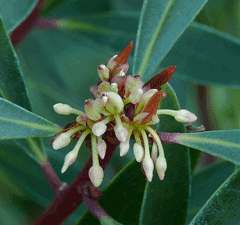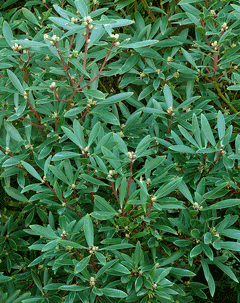 |
|
http://flickr.com/photos/jim-sf/ |
 |
| http://flickr.com/photos/jim-sf/ |
Translate this page:
Summary
Physical Characteristics

 Drimys lanceolata is an evergreen Shrub growing to 4.5 m (14ft) by 2.5 m (8ft) at a slow rate.
Drimys lanceolata is an evergreen Shrub growing to 4.5 m (14ft) by 2.5 m (8ft) at a slow rate.
See above for USDA hardiness. It is hardy to UK zone 8. It is in leaf all year, in flower from April to May, and the seeds ripen from September to October. The species is dioecious (individual flowers are either male or female, but only one sex is to be found on any one plant so both male and female plants must be grown if seed is required). . The plant is not self-fertile.
Suitable for: light (sandy) and medium (loamy) soils and prefers well-drained soil. Suitable pH: mildly acid and neutral soils. It can grow in semi-shade (light woodland). It prefers moist soil. The plant can tolerates strong winds but not maritime exposure.
UK Hardiness Map
US Hardiness Map
Synonyms
D. aromatica. (R.Br.)Muell. non Murray. Tasmannia aromatica. Winteriana lanceolata.
Plant Habitats
Woodland Garden Dappled Shade; Shady Edge; Hedge;
Edible Uses
Edible Parts: Fruit Seed
Edible Uses: Condiment
The fruit and seed are used as a pepper and allspice substitute[1, 2, 11, 46, 61, 105, 183]. A pungent flavour[183, 193]. The aromatic berries are edible according to one report[238], whilst another says that they taste somewhat like cinnamon.
References More on Edible Uses
Medicinal Uses
Plants For A Future can not take any responsibility for any adverse effects from the use of plants. Always seek advice from a professional before using a plant medicinally.
Antiscorbutic Stomachic
Antiscorbutic, stomachic[152].
References More on Medicinal Uses
The Bookshop: Edible Plant Books
Our Latest books on Perennial Plants For Food Forests and Permaculture Gardens in paperback or digital formats.

Edible Tropical Plants
Food Forest Plants for Hotter Conditions: 250+ Plants For Tropical Food Forests & Permaculture Gardens.
More

Edible Temperate Plants
Plants for Your Food Forest: 500 Plants for Temperate Food Forests & Permaculture Gardens.
More

More Books
PFAF have eight books available in paperback and digital formats. Browse the shop for more information.
Shop Now
Other Uses
References More on Other Uses
Cultivation details
Requires a light lime-free soil in semi-shade[200]. Prefers a fertile moist but well-drained soil[188]. A fairly hardy species, surviving very cold winters in various parts of the country so long as it is in a suitable position[120]. It tolerates temperatures down to about -15°c[184], but plants are liable to be damaged in cold winters. This species is hardier than D. winteri according to one report[120] whilst another says that it is less hardy than D. winteri[200]. All parts of the plant are very aromatic and pungent[182, 184]. Plants in this genus are notably resistant to honey fungus[200]. Plants are usually dioecious though monoecious and hermaphrodite forms are known. Male and female plants must usually be grown if seed is required.
References Carbon Farming Information and Carbon Sequestration Information
Temperature Converter
Type a value in the Celsius field to convert the value to Fahrenheit:
Fahrenheit:
The PFAF Bookshop
Plants For A Future have a number of books available in paperback and digital form. Book titles include Edible Plants, Edible Perennials, Edible Trees,Edible Shrubs, Woodland Gardening, and Temperate Food Forest Plants. Our new book is Food Forest Plants For Hotter Conditions (Tropical and Sub-Tropical).
Shop Now
Plant Propagation
Seed - best sown as soon as it is ripe in the autumn in a greenhouse[200]. When they are large enough to handle, prick the seedlings out into individual pots and grow them on in the greenhouse for at least their first winter. Plant them out into their permanent positions in late spring or early summer, after the last expected frosts. Cuttings of half-ripe wood, 10 - 15 cm with a heel, July/August in a frame. Approximately 60% take[78]. Layering in March/April. Takes 12 months[78]. Cuttings of mature wood of the current year's growth with a heel of older wood, November in a cold frame[78].
Other Names
If available other names are mentioned here
Native Range
AUSTRALASIA: Australia, Tasmania, New South Wales (southeast), Victoria,
Weed Potential
Right plant wrong place. We are currently updating this section.
Please note that a plant may be invasive in one area but may not in your area so it's worth checking.
Conservation Status
IUCN Red List of Threatened Plants Status :

Growth: S = slow M = medium F = fast. Soil: L = light (sandy) M = medium H = heavy (clay). pH: A = acid N = neutral B = basic (alkaline). Shade: F = full shade S = semi-shade N = no shade. Moisture: D = dry M = Moist We = wet Wa = water.
Now available:
Food Forest Plants for Mediterranean Conditions
350+ Perennial Plants For Mediterranean and Drier Food Forests and Permaculture Gardens.
[Paperback and eBook]
This is the third in Plants For A Future's series of plant guides for food forests tailored to
specific climate zones. Following volumes on temperate and tropical ecosystems, this book focuses
on species suited to Mediterranean conditions—regions with hot, dry summers and cool, wet winters,
often facing the added challenge of climate change.
Read More
Expert comment
Author
(Poir.)Baill.
Botanical References
11200
Links / References
For a list of references used on this page please go here
Readers comment